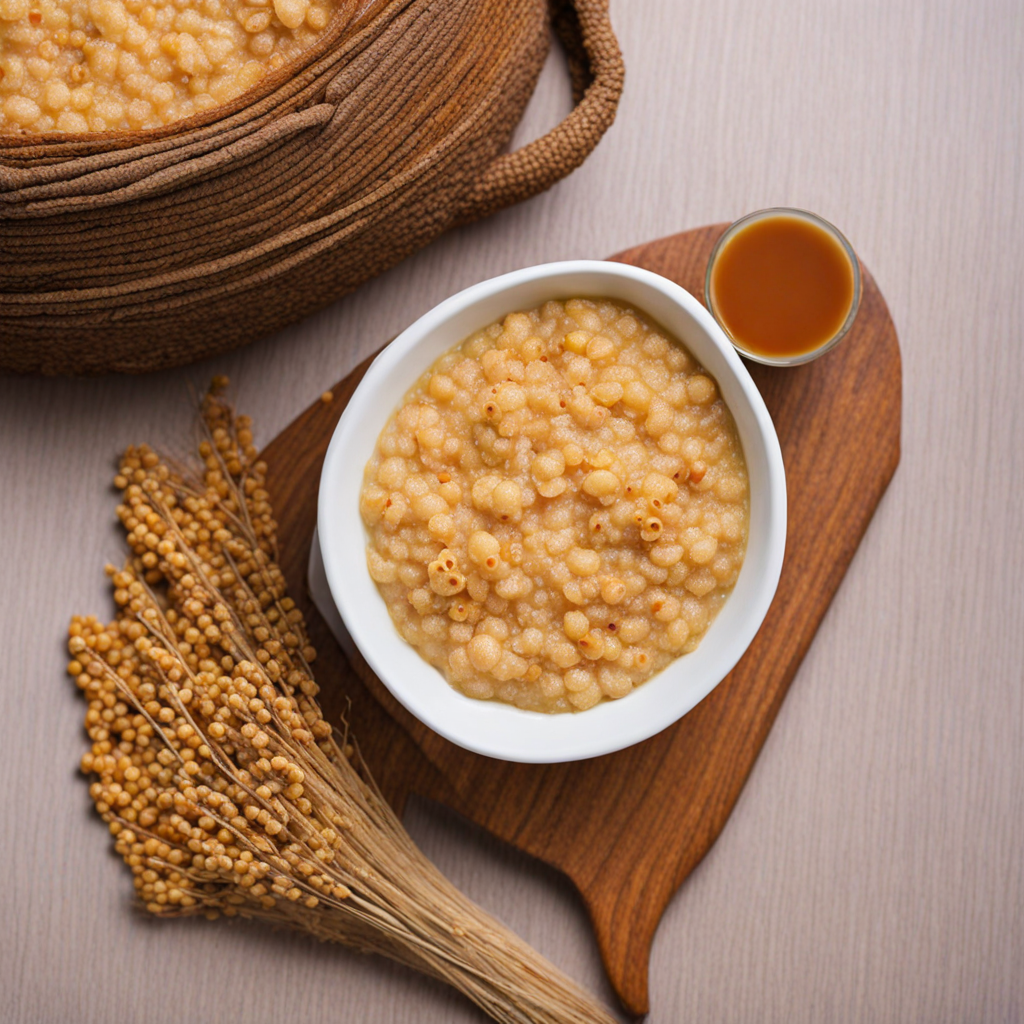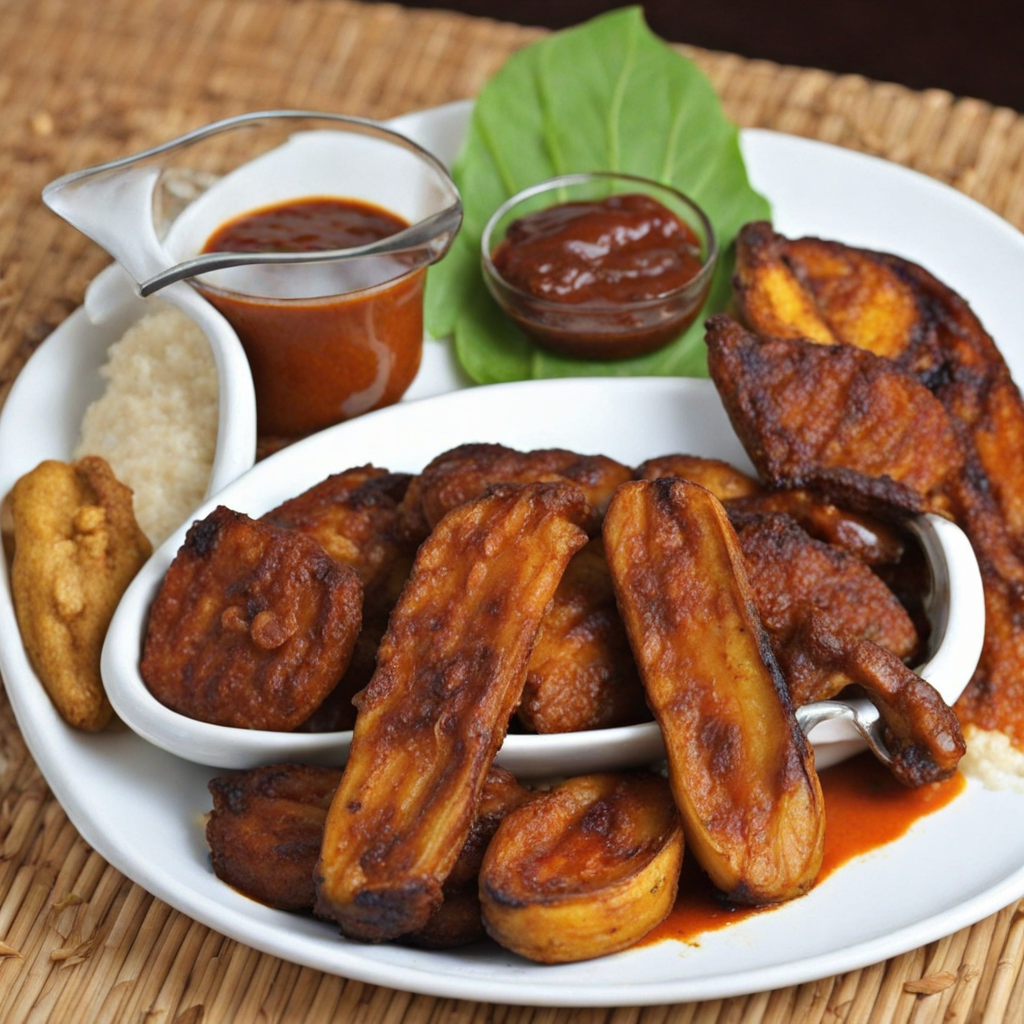Akamu
Akamu, also known as Ogi or Pap, is a traditional Nigerian fermented cereal pudding made primarily from maize, sorghum, or millet. The process of making Akamu involves soaking the grains in water, allowing them to ferment for a few days, and then grinding them into a smooth paste. This fermentation gives Akamu its unique tangy flavor and creamy texture, making it a deliciously comforting dish. The subtle sourness of Akamu is complemented by its creamy consistency, creating a delightful mouthfeel that is both refreshing and satisfying. Typically enjoyed as a breakfast dish, Akamu is often served with sugar, honey, or milk for those who prefer a sweeter taste. Some people enjoy it with savory accompaniments like beans or stews, allowing for a versatile culinary experience. The dish is not only delicious but also nutritious, packed with probiotics from the fermentation process, which can aid in digestion and overall gut health. The versatility of Akamu makes it suitable for various palates, appealing to those who enjoy both sweet and savory flavors. In Nigerian culture, Akamu is often associated with comfort and nurturing, commonly given to infants and young children as an easily digestible food. It is a dish that brings people together, often enjoyed during family gatherings and celebrations. The rich history of Akamu reflects the agricultural practices of Nigeria, showcasing how local grains can be transformed into a beloved staple. For anyone looking to explore the vibrant flavors of Nigerian cuisine, Akamu offers a unique taste experience that is both traditional and nourishing.
How It Became This Dish
Ogi: A Culinary Heritage of Nigeria Ogi, a fermented cereal pudding, holds a cherished place in Nigeria's culinary tapestry, embodying not just a staple food but also a rich cultural heritage. This age-old dish, known by various names across different ethnic groups, is primarily made from maize, sorghum, or millet and has been a significant part of the diets of many Nigerians, particularly the Yoruba, Igbo, and Hausa communities. To understand the significance of Ogi, we must delve into its origins, cultural relevance, and the evolution of its preparation and consumption over time. #### Origins of Ogi The roots of Ogi can be traced back centuries, originating from the agricultural practices of ancient African civilizations. While specific historical documentation is sparse, it is widely believed that the fermentation process used in making Ogi is a traditional method that dates back to pre-colonial times. The indigenous peoples of West Africa, particularly in Nigeria, began cultivating grains such as millet, sorghum, and maize long before European contact, and the knowledge of fermenting these grains for food and drink has been passed down through generations. The fermentation process not only preserved the grains but also enhanced their nutritional value, making Ogi a vital source of energy, vitamins, and probiotics, which are beneficial for gut health. The simplicity of Ogi's ingredients reflects the agricultural landscape of Nigeria, where these grains are commonly grown. As such, Ogi embodies the ingenuity of ancient food practices that utilized local resources to create nourishing meals. #### Cultural Significance Ogi is more than just a food; it is steeped in cultural rituals and social practices. In many Nigerian households, Ogi is often given to infants as one of their first solid foods, a practice that emphasizes its digestibility and nutritional benefits. The dish is particularly favored for its smooth texture and mild flavor, making it suitable for young children. In Yoruba culture, it is referred to as "akam," while in Igbo communities, it is known as "ogi" or "pap." The preparation and consumption of Ogi often come with social implications. It is a common sight at celebrations, including naming ceremonies and traditional festivals, where it is served alongside other dishes. In these contexts, Ogi symbolizes hospitality and community, fostering bonds among family and friends. The act of preparing Ogi can also be an intergenerational activity, where older family members pass down knowledge and techniques to younger generations, ensuring the continuity of this culinary tradition. Moreover, Ogi has economic significance. Its production supports local farmers who grow the cereals used in its preparation, contributing to the rural economy. The sale of Ogi and its derivatives has become a source of livelihood for many in Nigeria, particularly women who engage in its processing and distribution. #### Development Over Time As Nigerian society has evolved, so too has the preparation and consumption of Ogi. Traditionally, the process of making Ogi is labor-intensive and involves several steps: soaking the grains, wet-milling them into a smooth paste, fermenting the mixture, and then sieving to achieve the desired consistency. The fermentation process typically lasts from 24 to 72 hours, depending on environmental conditions, and the result is a slightly sour, creamy pudding that can be enjoyed plain or with added flavors. In recent years, modern conveniences and technological advancements have influenced the way Ogi is produced. While traditional methods are still prevalent, the introduction of industrial milling and packaging has made Ogi more accessible. Instant Ogi, a powdered form of the dish, has gained popularity among urban consumers for its convenience, allowing for quick preparation without the lengthy fermentation process. This shift has enabled Ogi to reach a broader audience, both domestically and internationally, as the diaspora seeks familiar flavors from home. The global interest in health and wellness has further elevated Ogi's status. As consumers become more aware of the benefits of fermented foods, Ogi is increasingly recognized for its probiotic properties and nutritional profile. This has opened avenues for Ogi to be marketed not only as a traditional Nigerian dish but also as a health food, aligning with contemporary dietary trends. #### Ogi in Contemporary Cuisine Today, Ogi is not only enjoyed in its traditional form but has also found its way into innovative culinary creations. Chefs and home cooks alike are experimenting with Ogi, incorporating it into smoothies, pancakes, and baked goods, showcasing its versatility beyond the traditional breakfast staple. This creative fusion highlights the adaptability of Ogi, allowing it to remain relevant in a fast-paced, globalized world. Moreover, Ogi is increasingly being recognized in the context of food security and nutrition. As conversations around sustainable food practices gain traction, the production of Ogi aligns with the movement towards utilizing local grains and promoting indigenous food systems. The emphasis on fermentation also speaks to a larger trend of reviving traditional food preservation methods, which have been largely overlooked in modern diets. #### Conclusion Ogi is a testament to Nigeria's rich culinary heritage, reflecting the country's agricultural history, cultural practices, and evolving food landscape. From its humble origins as a fermented cereal dish to its modern-day adaptations and growing recognition as a health food, Ogi embodies the resilience and creativity of Nigerian cuisine. It serves as a bridge between generations, linking the past with the present and ensuring that this traditional food continues to nourish and bring people together. As Ogi continues to evolve and adapt to contemporary tastes and lifestyles, it remains a symbol of identity, community, and sustainability. Its story is not just about food; it is about culture, history, and the enduring power of shared meals that transcend time and place. In a world that is increasingly leaning towards globalization, Ogi stands as a proud reminder of the importance of preserving and celebrating local food traditions.
You may like
Discover local flavors from Nigeria







